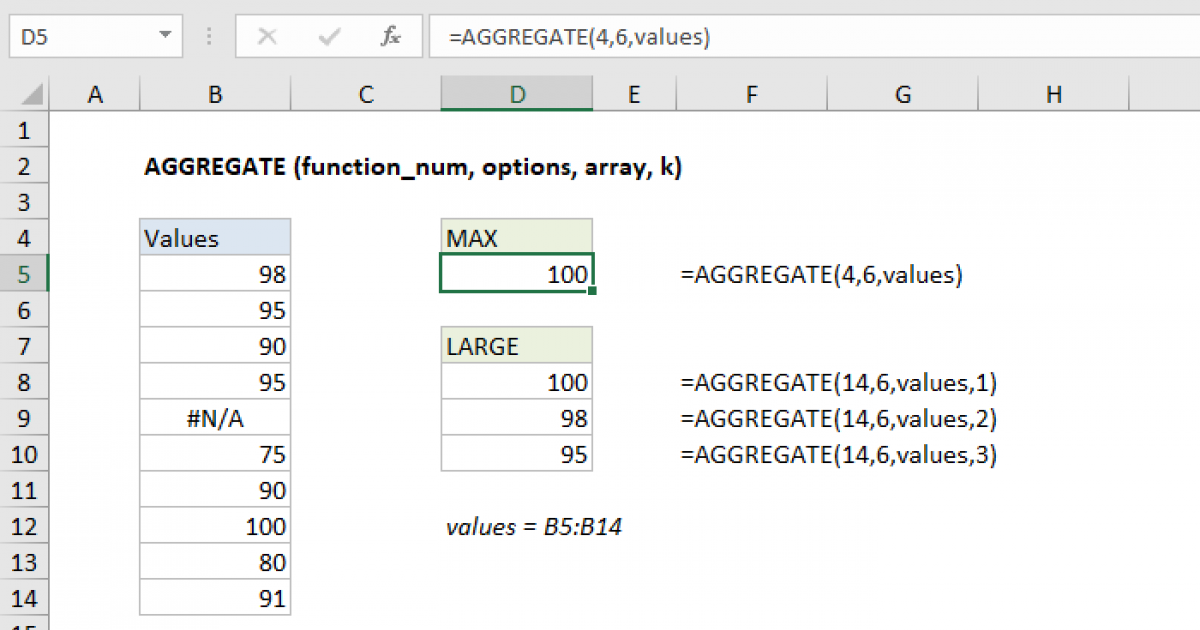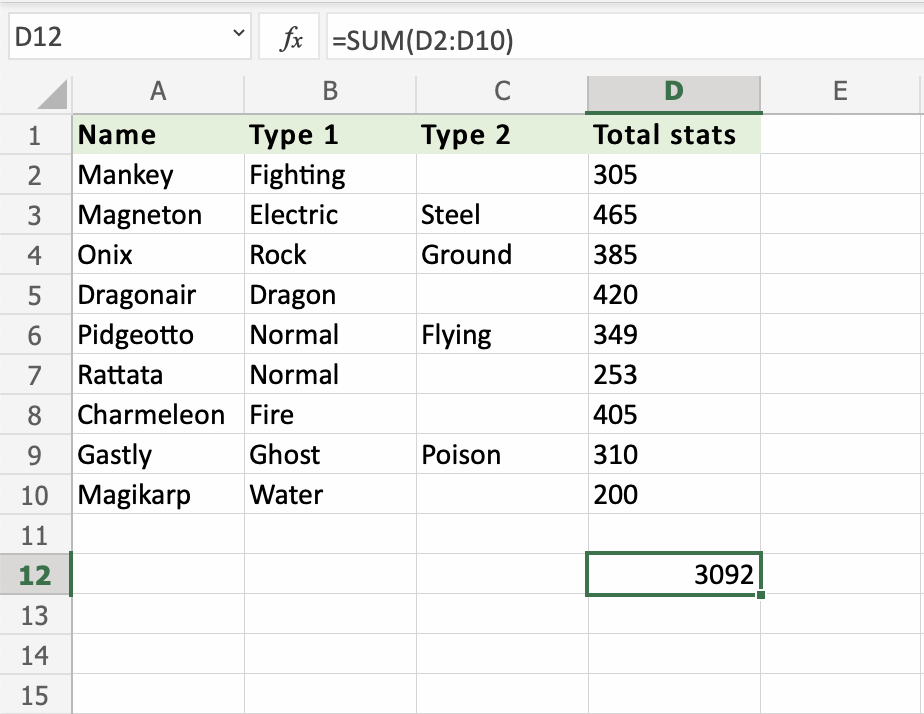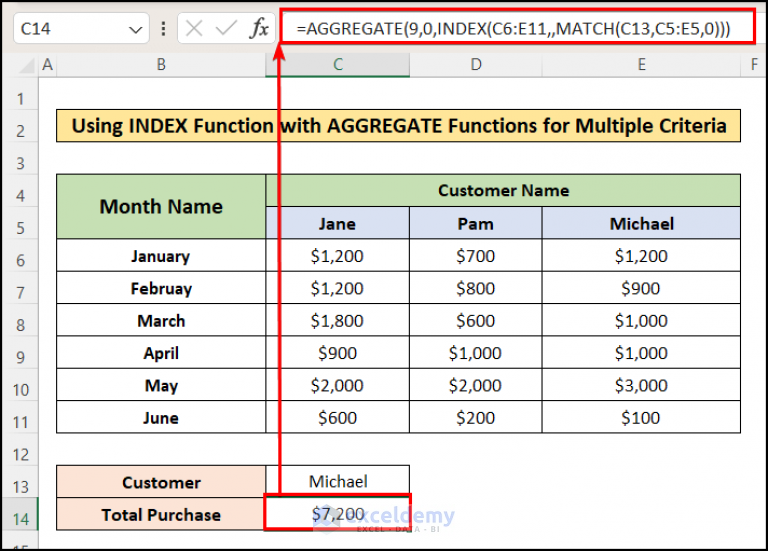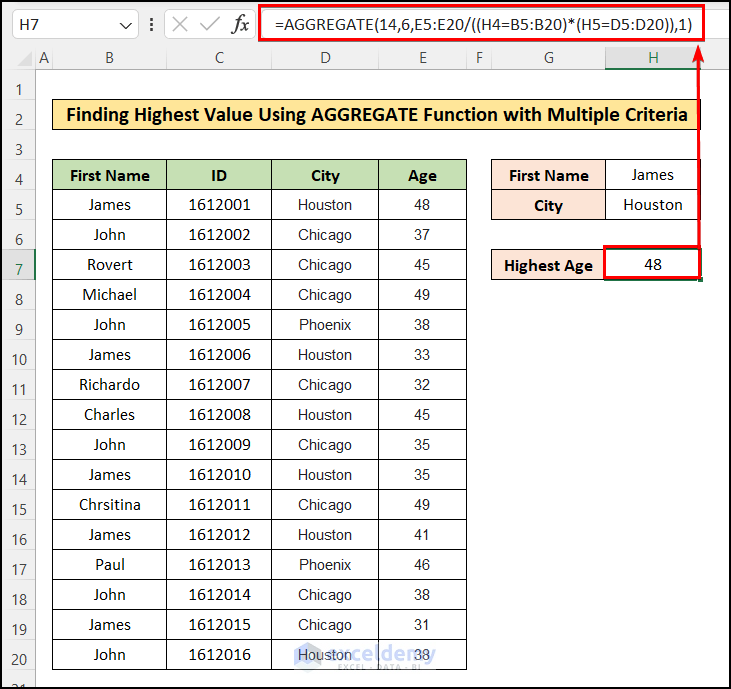
AGGREGATE Excel Function (Formula) How to Use AGGREGATE Function? YouTube
Description The AGGREGATE function is used on different functions like AVERAGE, COUNT, MAX, MIN, SUM, PRODUCT, etc., with the option to ignore hidden rows and error values to get certain results. Generic Syntax Syntax with References =AGGREGATE (function_num, options, ref1, ref2,.) Syntax with Array Formula

AGGREGATE Excel Function Formula, Examples, How to Use?
The Excel AGGREGATE function returns a aggregate calculation like AVERAGE, COUNT, MAX, etc., optionally ignoring hidden rows and errors. A total of 19 operations are available, specified by function number in the first argument (see table for options). Purpose Return aggregate calculation Return value Depends on function specified Syntax

Learn the AGGREGATE Function in Excel YouTube
Both forms of the Excel Aggregate Function receive the function_num argument (a number between 1 and 19 denoting the function to be performed), and the option argument (a number between 0 and 7 defining which values are to be ignored during the calculation). Possible values for these arguments, and their meanings, are listed in the tables below

AGGREGATE Excel Function Formula, Examples, How to Use?
The Microsoft Excel AGGREGATE function allows you to apply functions such AVERAGE, SUM, COUNT, MAX or MIN and ignore errors or hidden rows. The AGGREGATE function is a built-in function in Excel that is categorized as a Math/Trig Function. It can be used as a worksheet function (WS) in Excel.

AGGREGATE Excel Function Formula, Examples, How to Use?
Syntax Parameters or arguments The 19 functions supported by AGGREGATE The 8 options to handle errors and/or hidden rows How to use AGGREGATE function in Excel: Basic usage Excel AGGREGATE function: More examples Example #1: Data aggregation in Excel by ignoring hidden rows Example #2: Aggregation Excel - multiple references Example #3.

AGGREGATE Formula for Adding Serial Number in Excel
The Excel AGGREGATE function can be expressed in two different ways, as a reference formula or an array. The great thing is you don't need to worry about which one to use since Excel will select the right one for you automatically based on your input parameters. = AGGREGATE (function_num, options, ref1, [ref2],.) or

How to Aggregate Data in Excel (3 Easy Ways) ExcelDemy
The AGGREGATE function in Excel is an inbuilt function which means we can enter the formula directly in the worksheet or insert it from the " Math & Trig " option from the " Function Library ". For example, the first table below shows a student's scores in eight subjects.

AGGREGATE Excel Function & Formula Step by Step Guide Tim Vipond RapidFire Financial
The AGGREGATE function is a built-in function in Excel that allows you to apply functions such as SUM, AVERAGE, COUNT, MAX, and MIN to a range of cells or an entire column or row. You can use the AGGREGATE function to calculate measures such as standard deviation, variance, percentage change, etc.

Combining AGGREGATE with IF Function in Excel (4 Examples)
AGGREGATE function in Excel returns the aggregate of data provided in a table or data list. In the AGGREGATE function, the first argument is function number, and further arguments are for a range of the data sets. The reference syntax of the AGGREGATE formula is "=AGGREGATE (function_num, options, ref1, ref2, ref [3],…)"

How to Use AGGREGATE Function in Excel (13 Examples) ExcelDemy
What does the word aggregate mean? To form a whole from separate parts . That sounds the same as SUM doesn't it? Hence the problem with its name, the AGGREGATE function does so much more than SUM. AGGREGATE can COUNT, AVERAGE, MAX, SMALL and SUM, to name just a few.

Aggregate Function Excel Coupler.io Blog
The syntax: =AGGREGATE (function_num, options, ref1,.) My data is in an Excel Table called 'Table1', so I'm using the table Structured References in my formula. e.g. Table1 [Viewers] refers to cells C8:C19. I've used Option number 5, which ignores hidden rows (which really means rows hidden by a filter as rows hidden manually are.

Excel AGGREGATE function Exceljet
The AGGREGATE function in Excel enables you to perform calculations such as sum, average and count whilst ignoring criteria such as error values and hidden r.

How To Use Aggregate Function In Excel With Examples MOMCUTE
the range of cells we want to aggregate. k. (optional) returns the nth largest or smallest value when using the LARGE or SMALL function. Example 1: SUM (Ignore errors) Example 2: AVERAGE (Ignore hidden rows and errors) Example 3: LARGE (Ignore errors, hidden rows and return second largest)

How to Use Excel AGGREGATE Function with Multiple Criteria
The AGGREGATE function is used on different functions like AVERAGE, COUNT, MAX, MIN, SUM, PRODUCT, etc., with the option to ignore hidden rows and error values to get certain results. Generic Syntax: Syntax with References: AGGREGATE (function_num, options, ref1, ref2,.) Syntax with Array Formula: AGGREGATE (function_num, options, array, [k])

How to Use Excel AGGREGATE Function with Multiple Criteria
Excel AGGREGATE function (multiple criteria with examples). In this video, learn how to use AGGREGATE function numbers and options (1 to 19 numbers and 0 to.

AGGREGATE Excel Function Formula, Examples, How to Use?
The AGGREGATE function is designed for columns of data, or vertical ranges. It is not designed for rows of data, or horizontal ranges. For example, when you subtotal a horizontal range using option 1, such as AGGREGATE (1, 1, ref1), hiding a column does not affect the aggregate sum value.